Buchli drive
The Buchli drive is a drive for electric locomotives named after its inventor, the Swiss engineer Jakob Buchli , which was mainly used for express train locomotives in Switzerland and France . The Buchli drive is a fully sprung single axle drive with a drive motor housed in the locomotive body. The drive was very successful in the 1930s, but was then replaced by smaller, lighter drives that enabled higher speeds due to smaller imbalances .
construction
Each drive axle has its own motor, which is arranged in the sprung part of the vehicle. The weight of the drive motors is completely decoupled from the wheels, which are exposed to the bumps and blows of the rails.
The large wheel is firmly mounted in the locomotive box. It is connected to the wheel set on the rails via two control arms, which are mounted on rocker arms on the gear wheel. The rocker arms support each other with toothed rockers. This articulated mechanism allows the drive wheel set to move vertically in any position compared to the large wheel - in the transverse direction by sideways evasion of the links and vertical direction by the parallel movement of the link bearings on the rocker arms. The journals in the wheel set and the ends of the toothed rockers are spherical so that the coupling rods can incline in relation to the wheel planes. This means that the wheel set can also deflect on one side compared to the locomotive body. Since it can compensate for any movement of the unsprung wheelset and does not transfer it to the other drive train, it is considered a fully sprung drive. The unsprung mass is also relatively low and includes almost only the wheelset.
disadvantage
The weak point of the Buchli drive is its asymmetry and the associated uneven weight distribution between the left and right side of the locomotive. When using a one-sided Buchli drive, the heavy equipment in the locomotive body must be arranged opposite the drive side so that the left and right wheels of the wheelset each have the same wheel pressure. The locomotives therefore mostly had only one passage through the engine room, which led along the wall on the drive side.
Furthermore, the ball studs in the wheel lead to an imbalance in the wheel set, which makes counterweights necessary, which, however, can never completely cancel out the imbalance due to the moving parts.
Normal execution
The Buchli drive was mostly designed as a single-sided single-axle drive with an inner frame.
The locomotive frame with the wheelset bearings is located inside the wheel disks of the wheelset . On one side of the wheel set, the large wheel is mounted in a subframe outside the wheel set. It is surrounded by an eye-catching wheel protection box. Each large wheel is driven by its own motor above the large wheel in the locomotive body. In this version, the large external wheels in the chassis create a heavily one-sided weight distribution. So that the center of gravity of the locomotive remains on the longitudinal axis, the heavy equipment must be arranged in the engine room opposite the side with the drives. The locomotives have the asymmetrical appearance typical of the Buchli drive: on one side the wheel stars of the driving wheels are visible, on the other side they are almost completely covered by the wheel protection boxes of the large wheels.
Other designs
In addition to the normal version mentioned above, there were the following variants:
Execution with outer frame
The locomotive frame with the wheelset bearings is located outside the wheel disks of the wheelset. The wheel set is surrounded by a hollow shaft mounted in the locomotive body on which the large wheel sits.
Examples: Pennsylvania Railroad O1b , DR ET 11 01
Version with two-sided drive
The wheel set is coupled with two large wheels. The motor has a pinion on both sides. The pins in the wheel disc are rotated by 180 ° against each other, which can reduce the imbalance of the drive. Compared to the one-sided version, the double-sided version allows greater drive forces to be transmitted. With this arrangement, however, there is a risk of mechanical stresses in the drive parts. In order to keep them away from the drive motor shafts, the pinions are spring-loaded.
Examples: French express train locomotives: SNCF 2D2 5400 , SNCF 2D2 5500 , SNCF 2D2 9100
Version with two motors per axis
Two traction motors work on a common large wheel that is connected to a wheel set.
Examples: Pennsylvania Railroad O1b
probation
The Buchli drive made it possible for the first time to build powerful, fast-moving locomotives with single-axle drives in the 1920s. The possible gear ratios also allowed the installation of large engines, but thanks to the full suspension compared to the wheelsets, they did not place excessive stress on the tracks even when driving at high speed.
The disadvantage was the large number of moving parts, which required complex circulating oil lubrication and required careful maintenance. The Buchli drive therefore only caught on with high-performance express locomotives where there were no alternatives. The SBB had 240 locomotives with Buchli drives in service for over 60 years. The Ae 3/6 I were in operation for 73 years from 1921 to 1994. The French railways had 100 express locomotives in service for 50 years, with the drive being installed until the early 1950s. The Buchli drive is no longer used today because smaller, high-speed drive motors are available that enable lighter drives. In addition, with Buchli drives at speeds above 140 km / h, the imbalances caused by the drive components became too large - a disadvantage that was eliminated in the development step immediately following the Buchli drive with the SLM universal drive .
Vehicles with Buchli drive
| country | Railway company | model series | number | Construction year | Manufacturer | Axis formula | commitment | image |
|---|---|---|---|---|---|---|---|---|
|
|
SBB | Fb 2/5 | 1 | 1918 | SLM , BBC | 1 '(1Bo) 1' | Test locomotive |

|
|
|
SBB | Ae 4/8 | 1 | 1922 | SLM, BBC | (1'Bo1 ') (1'Bo1') | Test locomotive |
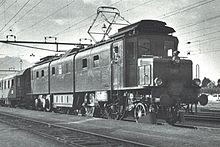
|
|
|
SBB | Ae 3/6 I. | 114 | 1920-1929 | SLM, BBC, | 2'Co1 ' | Universal locomotive |
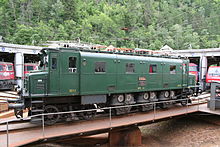
|
|
|
SBB | Ae 4/7 | 127 | 1927-1934 | SLM, BBC,
MFO, SAAS |
2'Do1 'or 2'Co (A1) | Universal locomotive |
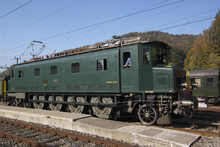
|
|
|
SBB |
Ae 8/14
11801 |
1 | 1931 | SLM, BBC | (1A) A1A (A1) + (1A) A1A (A1) | Freight locomotive |

|
|
|
DR | E 16 | 21st | 1926-1927
1932-1933 |
Krauss , BBC | 1'Do1 ' | Express trains |
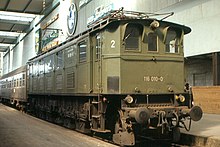
|
|
|
DR | ET 11 01 | 1 | 1935 | ME , BBC | Bo'2 '+ 2'Bo' | Railcar |
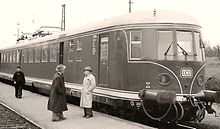
|
|
|
Budget |
Budget E 501-523
2D2 5400 |
23 | 1936-1938 | Fives-Lille , CEM | 2'Do2 ' | Express trains |
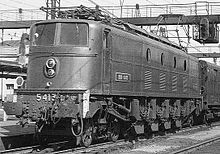
|
|
|
PO |
E 501-502
2D2 5501-5502 |
2 | 1925 | SLM, BBC | 2'Do2 ' | Express trains |
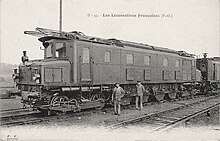
|
|
|
PO |
E 503-537
2D2 5503-5537 |
35 | 1933-1935 | Fives-Lille , CEM | 2'Do2 ' | Express trains |

|
|
|
PO |
E 538-545
2D2 5538-5545 |
8th | 1938 | Fives-Lille , CEM | 2'Do2 ' | Express trains |

|
|
|
SNCF | 2D2 5546-5550 | 5 | 1942-1943 | Fives-Lille , CEM | 2'Do2 ' | Express trains |
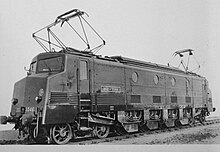
|
|
|
SNCF | 2D2 9100 | 35 | 1950-1951 | Fives-Lille , CEM | 2'Do2 ' | Express trains |

|
|
|
GIPR | EC / 1 | 1 | 1928 | Hawthorn Leslie , BBC | 2'Co'2 | Express trains |

|
|
|
ESS | 3000 | 2 | 1924 | SLM, BBC | (1A) Bo (A1) | Express trains |

|
|
|
JGR | 7000-7001 later ED54 | 2 | 1926 | SLM, BBC | (1A) Bo (A1) | Express trains |

|
|
|
ČSD | E 465 | 2 | 1927 | Breitfeld-Daněk , BBC | 1'Do1 ' | Passenger trains |

|
|
|
Paulista Railway | 320 | 1 | 1932 | SLM, BBC | 1'Do1 ' | Express trains |

|
|
|
PRR | O1b | 2 | 1931 | PRR, BBC | 1'Bo1 ' | Passenger trains |

O1 7850 with GE drive |
Patents
- Patent US1298881 : Shaft Coupling. Published April 1, 1919 , inventor: Jacob Buchli.
- Patent DE304997 : coupling. Registered December 7, 1916 , published April 19, 1918 .
- Patent US1683674 : Locomotive structure. Registered August 18, 1926 , published September 11, 1928 , inventor: Karl Howard.
literature
- Günter Kästner: Locomotives with Buchli drives . In: Wolfgang Messerschmidt (Ed.): Locomotive magazine . No. 59 . Franckh'sche Verlagshandlung, W. Keller & Co. , 1973, ISSN 0458-1822 , p. 158-163 .
- Gustav Nagel: An exotic thing in this country. The Buchli drive . In: LOK MAGAZINE . No. 253 / Volume 41/2002. GeraNova Zeitschriftenverlag GmbH Munich, ISSN 0458-1822 , pp. 64–65.
- Werner Nef: Buchli-Oldtimer der Schweiz , 2003, ISBN 3-7654-7125-9 .
- Karl Sachs: Electric traction vehicles , 1953, Volume I, pp. 298-301.
- Hans Schneeberger: The electric and diesel traction vehicles of the SBB, Volume 1: years of construction 1904–1955. Minirex, Luzern 1995, ISBN 3-907014-07-3
- Peter Willen: Locomotives in Switzerland, standard gauge traction units. 3rd edition, Orell Füssli Verlag, Zurich 1975, ISBN 3-280-00800-X



